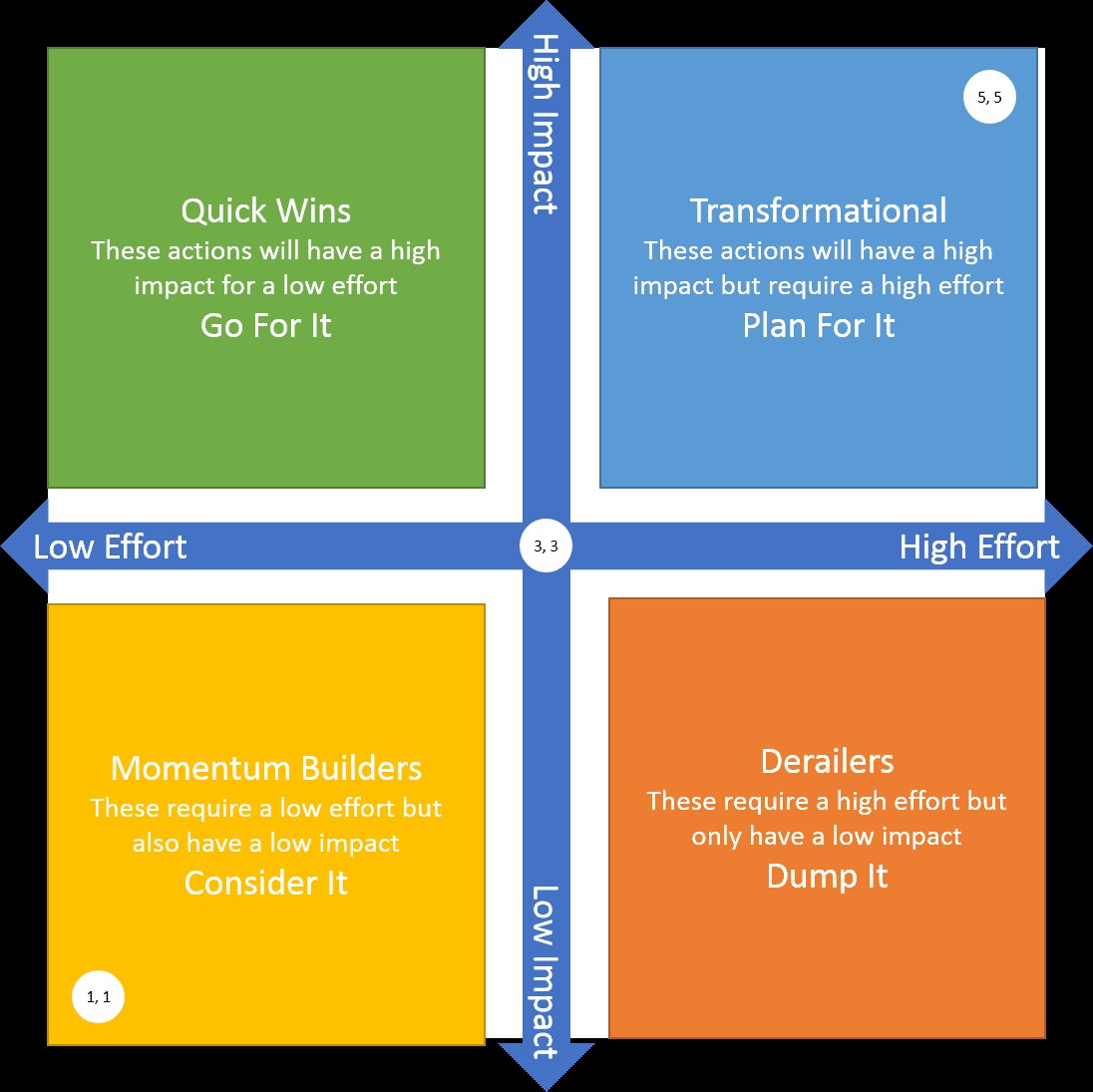Step 2 – Select from the menu the areas to prioritise
At this point many audit functions make the mistake of kicking off extensive change activity against all of the ideas generated in step 1. This is likely to lead to failure as you suffer from change overload, low levels of buy in and as a result poor adoption of the changes you are looking to make. The key is to prioritise - moving from a list of all the activity you could do towards a small initial targeted set of activity of what you should do. You need to select where to focus your finite resources carefully so that you can mobilise them in as an agile way as possible for quick delivery of value. You need to determine the sequence of change effort by looking at the amount of effort required to make the change happen and the impact the change is expected to have. One tool to help achieve this is an impact / effort grid as shown below:

The grid encourages you to prioritise the areas you wish to change and, from this, consider those that are:
- Quick wins - low effort, high impact items are easy ways to bring quick value at minimal effort. What are you waiting for, just get on with these!
- Potential momentum builders - low effort, low impact items may not be immediately appealing, but there may be some of these that can help you build momentum in your change programme so worth considering these. But be careful, too many of these will distract you from the higher impact possibilities.
- Transformational change items - high effort but high impact items need to be considered carefully. These items can be game changers for your audit function but take significant time and effort to deliver. Consider splitting them into more manageable activities and build more detailed management plans on how you would go about delivering the anticipated value.
- Derailers – Low impact high effort items should be immediately discarded as conducting this type of work will simply derail the higher impact activity. Resist the temptation to get involved in activity that you have identified in this quadrant.
Step 3 – Determine your year 1 priorities
Consider the rule of 5 – Having reduced the possibilities down you then need to select your initial priorities balancing the need for quick wins (low effort, high impact items) with more transformational change requirements. This stage takes management discipline to get to a manageable list of change initiatives that deliver value to stakeholders as quickly as possible. For example, one organisation I worked with had over 70 change projects running simultaneously having failed to prioritise this activity – this led to change chaos, low quality delivery by stretched colleagues and change fatigue by auditors expected to implement many of the ideas generated whilst delivering an already ambitious audit plan. It could not have been further away from the agile change approach to which they aspired. In my experience leadership teams can only truly give their attention to a maximum of 5-7 significant initiatives at any one time.
Limiting the focus to just 5-7 change activities sends a powerful signal to the internal audit function of the strategic intent of the leadership team and the desire to make the change sustainable and real rather than short lived and superficial. It also has the benefit of allowing genuine and deep cross functional cooperation to occur on each of the initiatives increasing the quality of deliverable and likelihood of successful adoption by all the auditors.
Whilst not perfect in determining your priorities the three-step approach outlined is powerful in facilitating discussion on where the internal audit change focus should be. This typically is the hardest part of the process and is likely to create much heated discussion, particularly around the value that the activities identified will bring. This dialogue is an important part of aligning the leadership team around a clear set of priorities that can then be shared with the rest of the audit team.
So at this point in the development of your internal audit functional strategy you have a compelling purpose, a series of future focused aspirational outcomes which you can align the function behind and now a prioritised list of change activity to deliver to help make these outcomes become increasingly true. But how do you organise to deliver these outcomes and the associated agreed change activity? What do you need to do to ensure that when they are delivered that the intended value is delivered and sustained over time? The next article in this series will explore the fourth and final characteristic of internal audit functional strategy, namely ‘Organising to deliver through developing a culture of continuous internal audit improvement’.

